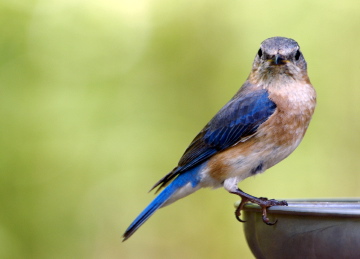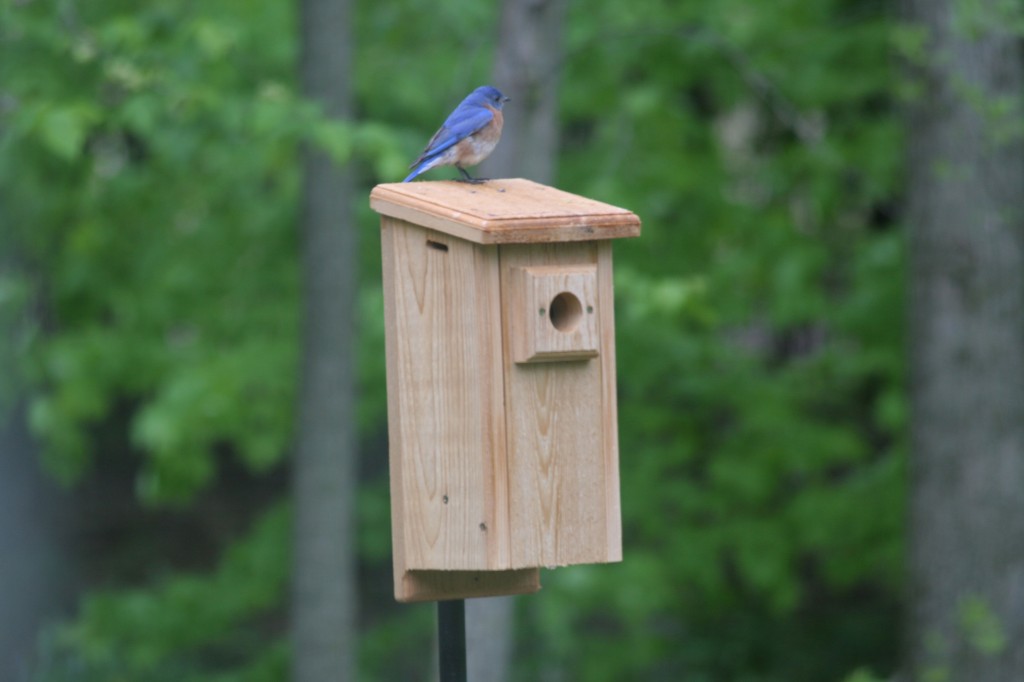- Bird Accessories, Bird Feeders, Bluebird Feeders, Fruit, Jelly & Mealworm Feeders, Live Meal Worms, Mealworm Feeder, Uncategorized
Try a Mealworm Feeder for Bluebirds
In order to entice bluebirds, sometimes their very favorite food must be offered. And meal worms happen to be what’s on the menu over here. Live mealworms are best, but dried or roasted ones will also work. One of the problems is that many species really enjoy mealworms, and you can find your supply dwindling quickly if fed in an open tray-type or dish feeder. Live mealworms are available in bulk quantities should this become habit forming too. They’re simple to store…just place in in a container in your fridge. Air holes are needed, but the worms stay in a dormant state until warmed up by the sun or room temperatures.
A mealworm feeder that’s made especially for bluebirds is one that is enclosed, in fact they’re called Bluebird Feeders. Consisting of two, four, or sometimes six entrances, they have clear acrylic panels for closures, and they’re meant for bluebirds only. Some feeders have a dish in the center for the worms, while others have a recessed circle for them. The birds must fly into the feeder to retrieve the worms, and very few species will try this. But somehow, the natural instinct of bluebirds tells them to do so.
It’s amazing to watch, especially when parent bring babies over at feeding time. At first the chicks don’t understand how to get inside, but they learn quickly. And once they learn how to get the food, they frequent the feeder often. This has got to be one of the best scenes of backyard birding!
Available in standard wooden models, mealworm feeders also come in recycled plastic versions. The advantage with
recycled plastic is that the feeder will never crack, split, or rot like wood tends to do over the years. Also keeping plastics out of landfills is huge plus to the environment.
Now I wish the nasty starling who tried to shove himself through one of the entrances would’ve gotten stuck there!
- Bat Houses, Bats & Butterflies, Bird Accessories, Bird Feeders, Bluebird Feeders, Live Meal Worms, Uncategorized
Bluebirds and Bat Houses?
Today the post was planned for bat houses, and this Colony bat house accommodates dozens of mature bats and their offspring. You can control mosquito populations around your yard by inviting little brown bats to take up residence.
And that’s all for bat houses, because I was more excited about my bluebird fledglings today! For the first time ever, I was lucky enough to witness all four babies inside the mealworm feeder at once. What a rewarding moment, to finally see them enter the feeder themselves and learn to retrieve the worms. We had 2 successful broods this season, with three fledglings and then four.
First on the scene was a female baby, and since she was all by herself, it caught my attention. As I went to sit outside with the binoculars, she flew off, but I was able to spot her perching high above in the pine tree. Several minutes went by, and no signs of the family. First thought is always, I hope they’re okay?
I went inside to feed the critters, but kept watching out the kitchen window. A juvenile male appeared (from the first brood) and sat on top of the feeder. Then they all came, numbers one, two three and four! The older brother entered the feeder, and a few seconds later a baby male went right in. The other three flew from the nearby shepherds’ hook and sat on top for a few seconds. One by one, they hopped on in! Now there’s five birds inside the feeder, and I’m thinking: “how are they going to get out?” It was very crowded in there! Next came daddy, the adult male landed on he shepherds’ hook as if to say “good job!” Then one by one, just as they had entered, they flew out.
It was one of the best sightings this season, and I’m just so sorry that I couldn’t catch it on film, because it was all just so perfect!
- Bird Accessories, Bird Baths, Bird Feeders, Bird Houses, Blue Bird Houses, Bluebird Feeders, Bluebird Houses
Invite Bluebirds to Nest with Bluebird Houses
Once abundant throughout the US, the North American Bluebird experienced a severe decline in population mostly due to competition for nest sites by non-native species, loss of habitat and pesticide use. The House Sparrow and Starling are both fierce competitors for available nest sites, and are known to be very aggressive towards Bluebirds.
Thanks to efforts by Bluebird Societies and many people who have constructed bluebird trails with nest boxes, their numbers continue to increase.
Encourage bluebirds to nest in your yard by providing bluebird houses. North American Bluebird Society (NABS) approved houses are best, to ensure successful broods.
Bluebirds prefer open, grassy areas where they can perch and easily hunt their main diet…insects. Beneficial to your environment, they eat insects considered to be damaging to gardens, like cutworms.
Providing Bluebird Feeders with meal worms will also help attract them to your yard. For some reason…no other bird will enter a bluebird feeder!
Our 2 successful broods this season were attributed to feeding meal worms daily and providing several fresh water sources…the babies are adorable, we hope to see them next year too!





